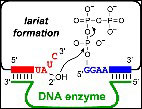Articles and reports from the Life Sciences and chemistry area deal with applied and basic research into modern biology, chemistry and human medicine.
Valuable information can be found on a range of life sciences fields including bacteriology, biochemistry, bionics, bioinformatics, biophysics, biotechnology, genetics, geobotany, human biology, marine biology, microbiology, molecular biology, cellular biology, zoology, bioinorganic chemistry, microchemistry and environmental chemistry.

Almost every week we hear of a new genome sequence being completed, yet turning sequence information into knowledge about what individual genes do is very difficult. An article published in Journal of Biology this week will simplify this task, as it describes a new online tool that dramatically improves predictions of how individual genes are regulated. Dr. Wyeth Wasserman and his team have created this powerful new two-step method for identifying which regulators of gene expression, called

Feeding birds display similar habits to human consumers shopping for food, according to research published in the current edition of the Proceedings of the Royal Society.
A two-year study has discovered it is possible to influence hummingbirds’ choice of food by changing the options available to them, in the same way supermarkets can manipulate customers’ preferences by clever positioning of products.
The study is published in the current edition of Proceedings of the Royal Society

Using a laser range-finder, neurobiologists have scanned real-life scenes to gather millions of distance measurements to surfaces in each scene — analyzing the mass of data to explain a series of long-known but little-understood quirks in how people judge distances.
The measurements reveal, for example, that the tendency of people to estimate the distance of isolated objects as being six to 12 feet away arises because that is the average distance of actual objects and surfaces in the visual

University of Colorado at Boulder researchers have discovered four new kingdoms of life in the high alpine environment of Colorado, findings that have potential applications in the fields of agriculture and global change.
Doctoral student Allen Meyer and Professor Steven Schmidt of the environmental, population and organismic biology department discovered the new microbe kingdoms in barren, boulder-filled tundra slopes west of Boulder.
At altitudes of 11,000 feet to 13,000 feet in

An Oxford University study has found a gene which predisposes people to asthma and atopy, a form of hypersensitivity which causes allergies. This discovery, published on Sunday [18 May] online in nature genetics, has the potential to lead to better classification of asthma and to new treatments.
Asthma affects one child in seven in the UK and there are 155 million cases of the disease in the world today. Asthma and allergies run strongly in families and have a genetic basis.
Funded

The production of lariat RNAs is a key step in the biologically important process of splicing. Because splicing changes the protein that is made from a given gene, a fundamental understanding of splicing is critical for comprehending the connections between genes and proteins. The study of splicing, however, has been very difficult in part because lariat RNAs have been nearly impossible to make artificially.
Now, chemistry professor Scott K. Silverman and graduate student Yangming Wang at th